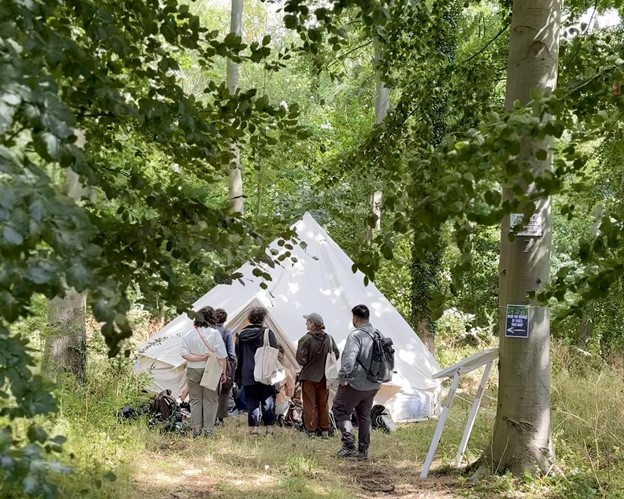At this year’s Groundswell Festival, we, Rye Hickman and Alex Montgomery, PhD students from the UK Food Systems Centre for Doctoral Training, collaborated with ecologists to pause and listen to the soil. Resonating Fields was a collaborative installation secluded in the woods, away from the buzz of the festival where people came to immerse themselves in the hidden soundscapes of the world beneath our feet.

We wanted participants to listen, be curious, and come asking what does soil sound like? And more importantly, how might listening to it affect the way we understand, conceptualise, and relate to soil?
We were joined by colleagues Tom Martin, Oli Hattingh, Ella Browning, Sam Bonnet, and Alice Eldridge, to host three interactive sessions during the festival. We began with a simple proposition: close your eyes and listen. In the first, we played uncontextualized soil sounds for fifteen minutes, letting the pops, crackles, and scratches of worms, ants, and other soily creatures fill the space. In the second and third sessions, Samar Khan, researcher and educator, led guided meditations that invited participants to embody the perspective of below-ground beings.

We wanted to both inform and open a space of wonder, dialogue, and critical reflection. For many, this was their first encounter with the concept of soil bioacoustics. And for us, an invaluable opportunity to share the promise and complexity of this emerging field. We deliberately offered the sounds without explanation, prompting participants to ask, What did I just hear?
From there, we were able to discuss both the potential and the uncertainties of soil bioacoustics as a tool for monitoring and relating to soil and its health. The response was overwhelmingly positive. Farmers, researchers, educators, and festival-goers from the UK and Europe thanked us for offering a moment of reflection, curiosity, and empathy, telling us:
“Quietness brought a sense of worry for the soil.”
“We’re very visual creatures. It’s nice to step outside of that primary sense of vision.”
“The ants sounded frantic.”

As researchers, we are excited by the possibilities of non-invasive, real-time biodiversity monitoring through sound. But we are also aware of the need for open debate around the ethics, ownership, and interpretation of this data, especially as commercial interest in this technology grows.
Groundswell helped strengthen our commitment to keeping this field open, accessible, and collaborative. One of the key insights we walked away with was the need for an open-source soil sound library. Something that could serve both research and public engagement. We are exploring ways to collaborate with new interested parties about developing a bioacoustic archive and considering the potential for a citizen science project that maps the sounds of soil across the UK.
Most of all, the experience reminded us of the power of interdisciplinary work. Coming together from different disciplinary and artistic backgrounds, we deepened our understanding of each other’s research and uncovered new ways to collaborate. Soil bioacoustics sits at the intersection of ecology, technology, and art. And its future depends on continued dialogue across these domains.
Groundswell 2025 gave us a glimpse of that future, and we’re excited to keep listening.

